
|
xTuple ERP Reference Guide |
To enter a new To-Do item, select the "New To-Do Item" option. The following screen will appear:
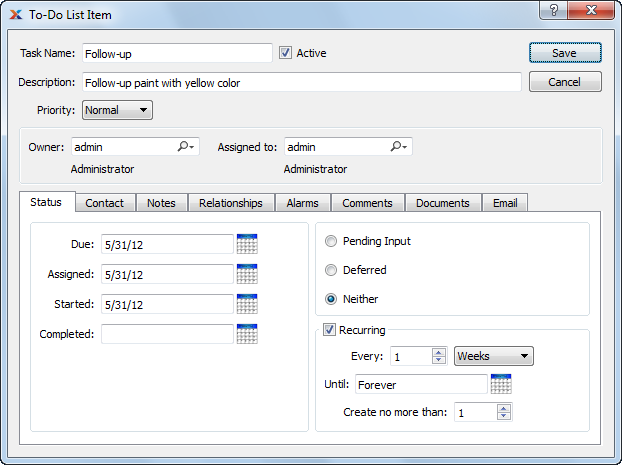
When entering a new To-Do item, you are presented with the following options:
Enter a name to describe the Task. Duplicate Task Names are allowed.
Select to indicate the To-Do item is active.
Enter a brief description of the To-Do item.
Enter a priority from the drop down list to help you prioritize your To-Do items. Priority options include, Very High, High, Normal, Low, Very Low
By default, a new To-Do item is owned by the user who creates it. Once a To-Do item has been created, it may be reassigned to another user.
To assign a To-Do item to another user, use the lookup feature located to the right of the field.
Specify the date when the To-Do item is due.
Specify the date when the To-Do item was assigned—or reassigned.
Specify the date when work on the To-Do item was started.
Specify the date when work on the To-Do item was completed.
Select to indicate the To-Do item is pending input. To-Do items having this status will display a "P" in the status column when they appear on the To-Do List.
Select to indicate the To-Do item is deferred. To-Do items having this status will display a "D" in the status column when they appear on the To-Do List.
Select to indicate the To-Do item is neither pending input nor deferred. To-Do items having this status will display an "I" in the status column when they appear on the To-Do List.
When creating a recurring event, you are presented with the following options:
Check this box if you want the event to repeat itself at regular intervals, using the frequency settings you specify below. Recurring events are generated when you run the recurring items utility, which is described in more detail here: Section 9.2, “Create Recurring Items”.
Enter a number and select a unit of time to describe how frequently you want the event to occur. You can choose any regular schedule, ranging from once every 1 minute to once every 99 years.
Enter a date and time at which to start the first event. The default value is the time the screen opened. The "From" option only appears on some screens.
Enter a date and time after which the event should no longer occur.
Enter the maximum number of future copies of this event you want the system to maintain. Whenever the Create Recurring Items screen is run, it will create up to the number you enter here.
If you delete all copies of a recurring event, the event will stop repeating even if the "Until" date has not yet been reached. xTuple recommends setting this to at least 2 to reduce the likelihood of deleting all copies of the event.
To associate a Contact with a To-Do Item, select the "Contact" tab. The following screen will appear:
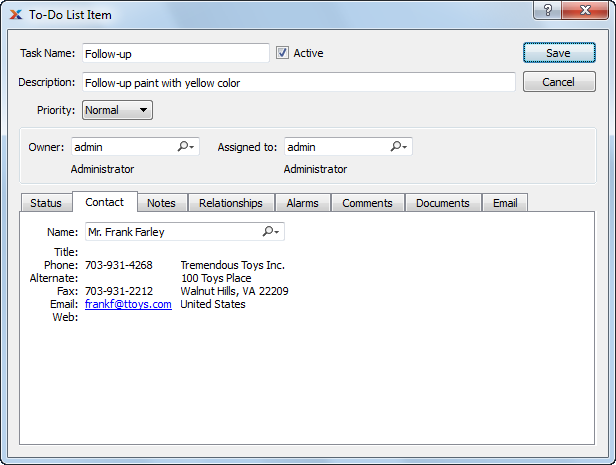
Enter the name of the Contact—or select a name from the Contacts list. Details for the Contact will be shown after selection.
To enter notes for a To-Do Item, select the "Notes" tab at the bottom of the screen, as shown below:

This is a scrolling text field with word-wrapping for entering Notes related to the To-Do item.
To create associations for a To-Do Item to other records, select the "Relationships" tab at the bottom of the screen, as shown below:
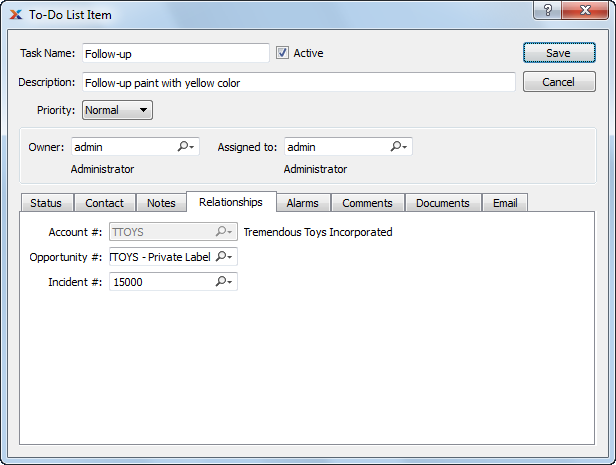
When defining To-Do Item relationships, you are presented with the following options:
Specify the CRM Account the To-Do item is associated with (if any).
Select an Opportunity (if applicable) to associate with the To-Do Item.
Select an Incident (if applicable) to associate with the To-Do Item.
To create reminder Alarms for a To-Do Item, select the "Alarms" tab at the bottom of the screen, as shown below:
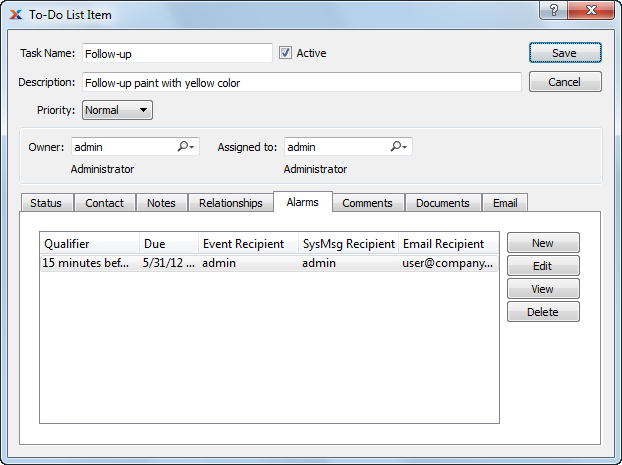
When creating reminder Alarms for To-Do Items, you are presented with the following options:
Displays a list of Alarms you can create to send reminders to various users associated with an Event or system message.
To add Comments to a To-Do Item, select the "Comments" tab. The following screen will appear:
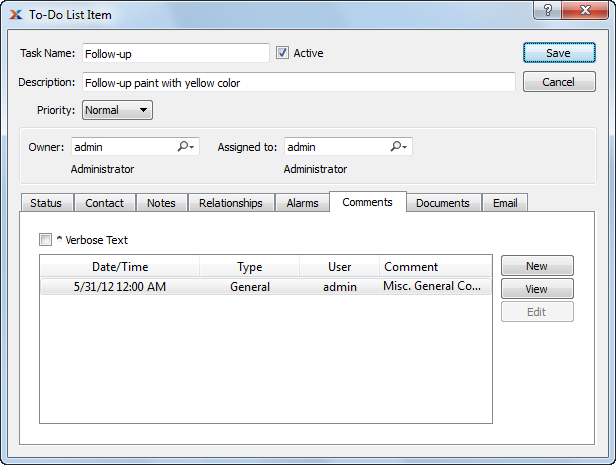
When adding or reviewing Comments, you are presented with the following options:
Select to display all Comments in the list in an expanded view which includes the entire text of each Comment. To edit a Comment, simply select the "Edit" link next to the Comment. That link will not be shown for Changelog Comments, which can't be edited. If the "Verbose Text" option is not selected, the Comment list will display only header level information for each Comment.
Display lists Comments related to the record.
The following buttons are available:
Opens screen for creating a new Comment.
Highlight a Comment and then select this button to reach a read-only view of the "Edit" screen.
Enables you to edit highlighted Comments—as long as the Comments are not "ChangeLog" Comments. ChangeLog Comments are system-generated and may not be edited. The edit screen is the same as that for creating a new Comment—except that when editing, the fields will contain Comment information. Double-clicking on a Comment will also bring you to the editing screen.
To enter a new Comment, select the NEW button. The following screen will appear:

Select a Comment Type from the drop-down list to classify the Comment. This is a required step. Comment Types may be system-defined (i.e., "ChangeLog" and "General") or user-defined, as described in Section 13.2.2, “Comment Types”. Once you have specified a Comment Type, begin typing your Comment in the main text area. The text area features word-wrapping and scroll-bar support for longer Comments.
The following buttons are unique to this screen:
Select to show the complete list (i.e., "thread") of Comments associated with the record. To hide the list, simply select the SHOW MORE button again. The Comment thread will show the most recent Comment first.
To view the documents associated with a To-Do Item, select the "Documents" tab. The following screen will appear:

To-Do Item Documents
When associating documents, you are presented with the following options:
Select to create a new document and associate it with the current record. You may create the following document types:
Select to create a new Image association.
Select to create a new Incident and associate it.
Select to create a new To-Do and associate it.
Select to create a new Opportunity and associate it.
Select to create a new Project and associate it.
Enables you to edit associated documents. The edit screen is the same as that for creating a new document—except that when editing, the fields will contain document information. Double-clicking on a document will also bring you to the editing screen.
Highlight a document and then select this button to reach a read-only view of the "Edit" screen
Select to associate already-existing documents. The following document types may be attached: Contact, Account, Customer, Employee, File, Image, Incident, Item, Opportunity, Project, Purchase Order, Sales Order, Vendor, Web Site, Work Order.
Highlight a document and then select this button to remove the association.
To associate already-existing documents, select the ATTACH button. The following screen will appear:
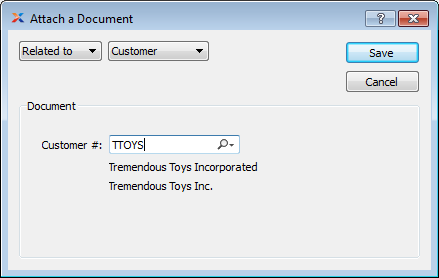
When associating already-existing documents, you are presented with the following options:
Indicate how the document is related to the current record. The following relationship options are available: Related to, Parent of, Child of, Duplicate of.
Specify the kind of document you want to associate. The following document types may be attached: Contact, Account, Customer, Employee, File, Image, Incident, Item, Opportunity, Project, Purchase Order, Sales Order, Vendor, Web Site, Work Order. When associating Files, you will also be given the option to save the File to the database.
There is no file size restriction when saving Files to the database. However, excessively large files could cause storage and performance issues.
Use the lookup field to identify the specific document you want to attach. The data entry options will vary depending on the document type you select.